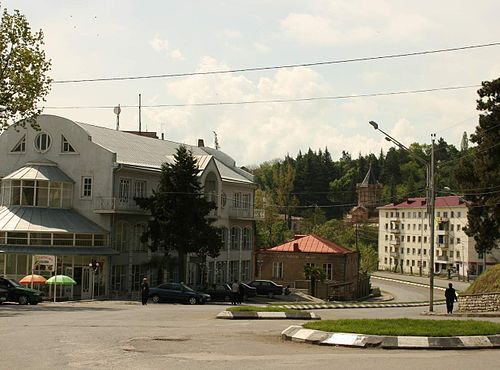























There is 2 centuries old press (equipment used for wine squeezing), which is until now used for the purpose of making wine and which presents the pride of our cellar. Here you can also see old earthen crocks ("kvevri"), where different types of wine are stored.
Wine house produces its own vintage wine (Kvevri), which is decorated with appropriate etiquette and production history. Guests can bottle wine which they take out of "kvevri" with their own hands and purchase it in a sealed condition. Professional (certified) sommelier lead the wine tasting for you. Our guest will have an opportunity to attend the brewing of Georgian Vodka ("Zavodoba"), which is very interesting process; we will also see how traditional Georgian bread is baked and how Churchkhela is made.
Brief lecture will be provided about masterpieces of Georgian cuisine, such as Khachapuri, Khinkali, Mtsvadi and many other Georgian dishes. You will have an opportunity to participate in this process and master old Georgian culinary technologies and finally taste the dishes made by your own hands. All this will be provided in a pleasant ethnographic environment decorated with old Georgian exhibits and other interesting things. Here is functioning the gift shop of interesting handicrafts.
Georgian folk group and tamada (toast-master) will make your banquet unforgettable.
In the wine house is provided all necessary conditions and comfort for the guests. About 10 to 15 persons can overnight simultaneously.
Gurjaani
| Gurjaani გურჯაანი | |
|---|---|
| Town | |
 Liberty Street, Gurjaani in 2011. | |
| Location of Gurjaani | |
| Coordinates: 41°45′N 45°48′E / 41.750°N 45.800°E / 41.750; 45.800Coordinates: 41°45′N 45°48′E / 41.750°N 45.800°E / 41.750; 45.800 | |
| Country | |
| Region | Kakheti |
| Municipality | |
| Town | 1934 |
| Elevation | 415 m (1,362 ft) |
| Population (2014)[1] | |
| • Total | 8,024 |
| Website | gurjaani.ge |
Gurjaani (Georgian: გურჯაანი) is a town in Kakheti, a region in eastern Georgia, and the seat of the Gurjaani Municipality. It is located in the Alazani River Plain, at an elevation of 415 m above sea level.
Gurjaani is first recorded as a village in a historical document of the early 16th century. It acquired the status of a town in Soviet Georgia in 1934. As of the 2014 census, Gurjaani had the population of 8,024. The town is the center of the largest wine-making region of Georgia.
Background[edit]
Gurjaani is situated in the fertile Alazani Plain, at 415 m above sea level, and 110 km east of Georgia's capital of Tbilisi. It is the center of an important region of viticulture and wine-making. Important landmarks of the town are Akhtala, a historic spa, locally known for its mud bathes, and the early medieval Gurjaani Kvelatsminda Church, the only example of a two-domed design in Georgia. There are also several museums, the largest of which is the Gurjaani Museum of Local Lore and History.
History[edit]
The territory of Gurjaani has not been systematically studied archaeologically. Occasional and incidental finds, such as burials, pottery, and Byzantine coins, suggest it was a home to an established settlement in the early Middle Ages. Gurjaani is first documented as a village in a charter issued in the name of King Alexander I of Kakheti (r. 1476–1511), granting the locale an exemption from taxation. In historical documents Gurjaani is frequently mentioned together with the toponym of Kakhtubani, which is now one of the town's neighborhoods and home to the Kvelatsminda Church. Gurjaani was in possession of the Andronikashvili noble family. As a result of a series of marauding inroads from the mountains of neighboring Dagestan, Gurjaani had been virtually depopulated by the 1770s.[2]
Gurjaani rose to a larger settlement when a railway was constructed in Kakheti in 1915. It became a center of the newly created homonymous district—a predecessor of the present-day municipality—in 1930 and became a town in 1934. During Soviet-era industrialization, Gurjaani had wine-making, canning, distilling, brick-making, and mechanical repair plants.
The post-Soviet political and economic crisis took its toll on Gurjaani in the 1990s. The population dwindled, industry declined, and violent crime was on the rise. An armed group with ties to the Mkhedrioni paramilitary organization was implicated in several high-profile murders.[3] The Mkhedrioni itself was in de facto control of the Gurjaani district from 1992 to 1995.[4] Despite political and relative economic stability achieved in the 2000s, Gurjaani still lacks some elements of proper urban infrastructure and services.






